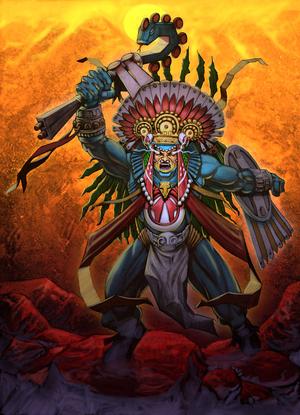In
Aztec religion, Huitzilopochtli, also spelled Uitzilopochtli (Classical
Nahuatl: Huitzilopōchtli, “Hummingbird on the Left”, or
“Left-Handed Hummingbird”, huitzilin being Nahuatl for hummingbird), was
a god of war, sun, human sacrifice and the patron of the city of
Tenochtitlan. He was also the national god of the Mexicas of Tenochtitlan.
Huitzilopochtli’s
mother was Coatlicue, and his father was a ball of feathers (or,
alternatively, Mixcoatl). His sister was Malinalxochitl, a beautiful
sorceress, who was also his rival. His messenger or impersonator was Paynal.
In
one of the recorded creation myths, Huitzilopochtli is one of the four sons
of Ometeotl, and he made the first fire from which a half sun was created by
Quetzalcoatl.
The
legend of Huitzilopochtli is recorded in the Mexicayotl Chronicle. His
sister, Coyolxauhqui, tried to kill their mother because she became pregnant
in a shameful way (by a ball of feathers). Her offspring, Huitzilopochtli,
learned of this plan while still in the womb, and before it was put into
action, sprang from his mother’s womb fully grown and fully armed. He then
killed his sister Coyolxauhqui and many of his 400 brothers. He tossed his
sister’s head into the sky, where it became the moon, so that his mother
would be comforted in

seeing
her daughter in the sky every night. He threw his other brothers and sisters
into the sky, where they became the stars.
Huitzilopochtli
was a tribal god and a legendary wizard of the Aztecs. Originally he was of
little importance to the Nahuas, but after the rise of the Aztecs, Tlacaelel
reformed their religion and put Huitzilopochtli at the same level as
Quetzalcoatl, Tlaloc, and Tezcatlipoca, making him a solar god. Through
this, Huitzilopochtli replaced Nanahuatzin, the solar god from the Nahua
legend. Huitzilopochtli was said to be in a constant struggle with the
darkness and required nourishment in the form of sacrifices to ensure the
sun would survive the cycle of 52 years, which was the basis of many
Mesoamerican myths. While popular accounts claim it was necessary to have a
daily sacrifice, sacrifices were only done on festive days. There were 18
especially holy festive days, and only one of them was dedicated to
Huitzilopochtli.
Every
52 years, the Nahuas feared the world would end as the other four creations
of their legends had. Under Tlacaelel, Aztecs believed that they could give
strength to Huitzilopochtli with human blood and thereby postpone the end of
the world, at least for another 52 years.
The
Great Temple of Tenochtitlan was dedicated to Huitzilopochtli and Tlaloc
because they were considered equals in power. The Templo Mayor actually
consisted of a pyramidal platform, on top of which were twin temples. The
left one was Huitzilopochtli’s, and the right one was Tlaloc’s.
According
to Miguel León-Portilla, in this new vision from Tlacaelel, the warriors
that died in battle and women who died in childbirth would go to serve
Huitzilopochtli in his palace (in the south, or left). From a description in
the Florentine Codex, Huitzilopochtli was so bright that the warrior souls
had to use their shields to protect their eyes. They could only see the god
through the arrow holes in their shields, so it was the bravest warrior who
could see him best. From time to time, those warriors could return to earth
as butterflies or hummingbirds.
In
the book El Calendario Mexica y la Cronografia by Rafael Tena and published
by the National Institute of Anthropology and History of Mexico, the author
gives the last day of the Nahuatl month Panquetzaliztli as the date of the
celebration of the rebirth of the Lord Huitzilopochtli on top of Coatepec
(Snake Hill); December 9 in the Julian Calendar or December 19 in the
Gregorian Calendar.
There
are several legends and myths of Huitzilopochtli. According to the Aubin
Codex, the Aztecs originally came from a place called Aztlan. They lived
under the ruling of a powerful elite called the “Azteca Chicomoztoca”.
Huitzilopochtli ordered them to abandon Aztlan and find a new home. He also
ordered them never to call themselves Aztec; instead they should be called
“Mexica.” Huitzilopochtli guided them through the journey. For a time,
Huitzilopochtli left them in the charge of his sister, Malinalxochitl, who,
according to legend, founded Malinalco, but the Aztecs resented her ruling
and called back Huitzilopochtli. He put his sister to sleep and ordered the
Aztecs to leave the place. When she woke up and realized she was alone, she
became angry and desired revenge. She gave birth to a son called Copil. When
he grew up, he confronted Huitzilpochtli, who had to kill him.
Huitzilopochtli then took his heart and threw it in the middle of Lake
Texcoco. Many years later, Huitzilopochtli ordered the Aztecs to search for
Copil’s heart and build their city over it. The sign would be an eagle
perched on a cactus, eating a precious serpent. The Aztecs finally found the
eagle, which bowed to them, and they built a temple in the place, which
became Tenochtitlan.
There
are different versions of this encounter, but generally the eagle is told to
have been eating a snake. This image is seen on the flag of Mexico.